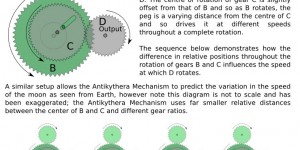There is a challenge issued in "The History Boys" by the morally ambivalent Irwin as he leads his students through a discussion of the holocaust:
Our perspective on the past alters. Looking back, immediately in front of us is dead ground. We don't see it, and because we don't see it this means that there is no period so remote as the recent past. And one of the historian's jobs is to anticipate what our perspective of that period will be....
(The History Boys)
This is a perfectly valid point, and all wrapped up in the notion of "distance". The archaeologist/historian can study the past because they are separated from it; be it by generations or by millennia. They are able to make conclusions about that past with less of the burden that living through a time period brings. The aim of the archaeologist, whether realised or not, is to interrogate and examine; this becomes much harder when what is being studied is the present. We are hampered by the ideological baggage of living through a society, unable to see ourselves with quite the same objective lens as we might like to. In this way the recent past, events that have been witnessed personally by those who are still alive today become 'dead ground'. There is something intriguing about predicting history, the allure of trying to understand our place in the grand scheme of things, and as such it is a worthy sideline of mainstream history.
What about archaeology? There has been some archaeology of the recent past, as we will see later, but it is hardly a focus of study. Ironically, Irwin's plea strikes more chords with archaeology than it does with history. As historians attempt to place the present in a wider historical context, so should the archaeologist, with their material fascination and particular methods.
However the material of our own contemporary society is profoundly interesting, not just the obvious technological advances, but because it is interesting to study the material of the present in archaeological terms and see what conclusions can be drawn. Take Buchli and Lucas's (2000) study of a council flat from the late 90's, the forensic study of the abandoned flat gives a refreshing insight into the mindset of the single mother. The presence of the absentee father's methadone prescription and lingerie in the mother's bedroom point to a continued relationship between the couple. However these purely forensic observations pale into insignificance compared to the remarkable observations made about the children. In the so-called 'tadpole' drawings made by the kids what the researchers interpreted as the father-figure stands apart from the family, who look towards him whilst he looks away. This observation is perhaps overstating what may in all honesty be a child's absent minded scrawling, but the parallels with the known family dynamic is suggestive to say the least. It is telling also that this article appears in a theoretical volume on the archaeology of childhood, and shows a child's sophisticated understanding of their surroundings. Also the classification of the drawing style with an art historical label, and unpicking the structure and symbolism of its meaning, takes a child-like scrawl and turns it into something profound.
These are the insights of contemporary archaeology; life according to the things we use and the images that we make. An interesting question might be how future archaeologists — if they indeed exist — will understand our obsession with collecting, using and then updating technology, and our almost clinical addiction to the computer and its various merits and vices. Also how will they judge our priorities, when we continue to view the personal car and the television as necessities on the verge of supposed economic collapse? When will modern graffiti art be given an archaeological / art historical classification, and what will its given purpose be? In short, how will we be remembered when the material we leave behind speaks for us?
Archaeology — they will tell you — is not objective, but a reflection of ourselves. If this is the case then surely an archaeological examination of the contemporary is perfectly valid, examining ourselves by our own terms. In such a way, if what we find is patently ridiculous, then there is clearly something wrong with archaeology. The Spitalfields project, for example, went some way to highlighting the 'problems' of osteological analysis, when the controvertible records of the church records disagreed significantly with the figures given by an archaeological analysis, especially in terms of age (Cox and Waldron 1993, Reeve and Adams 1993). While that is an example of historical / post-medieval archaeology, it raises the point that the flood of documentary evidence available to an archaeologist of the contemporary could be used to test archaeological techniques and examine their validity. If there is the need for a purpose in contemporary archaeology - to answer the cries of those who will wonder 'why bother studying the present?' - there are clear and obvious benefits here.
Contemporary archaeology however should not merely be seen as a testing ground for real archaeology. Fundamentally, it is interesting to study ourselves by the same means that we interrogate the past, and see what we come up with. As archaeology matures, it has begun to realise that its interest does not only lie in the far flung past. There is something to be learned from studying the present as with any other period of history, largely because it is just another period to be studied.## References
- Bennet, A. (2006) The History Boys
- Buchli, V. and Lucas, G. (2000) 'Children, gender and the material culture of domestic abandonment in the late twentieth century' in Derevenski, J. S. (ed) Children and material culture. London: Routledge
- Cox, M.; Waldron, K. H. and Whittaker, D. K. (1993) The Middling Sort: The Spitalfields Project Volume II. Council for British Archaeology: York
- Reeve, J. and Adams, M. (1993) Archaeology across the Styx: The Spitalfields Project Volume I. Council for British Archaeology: York





